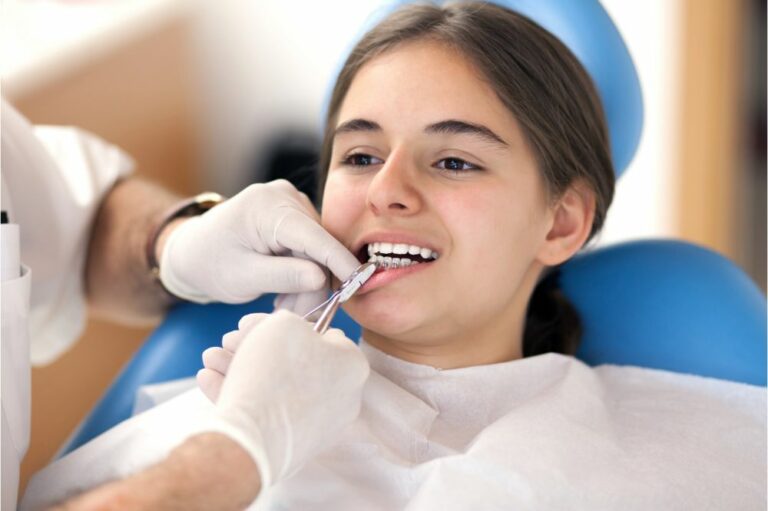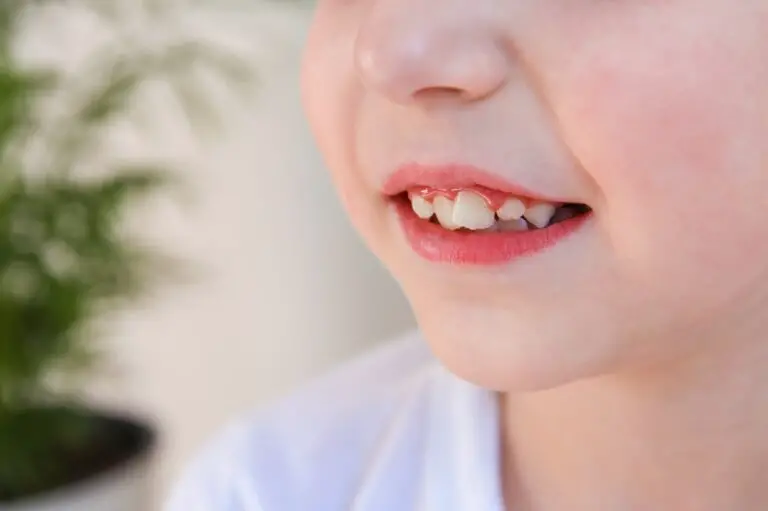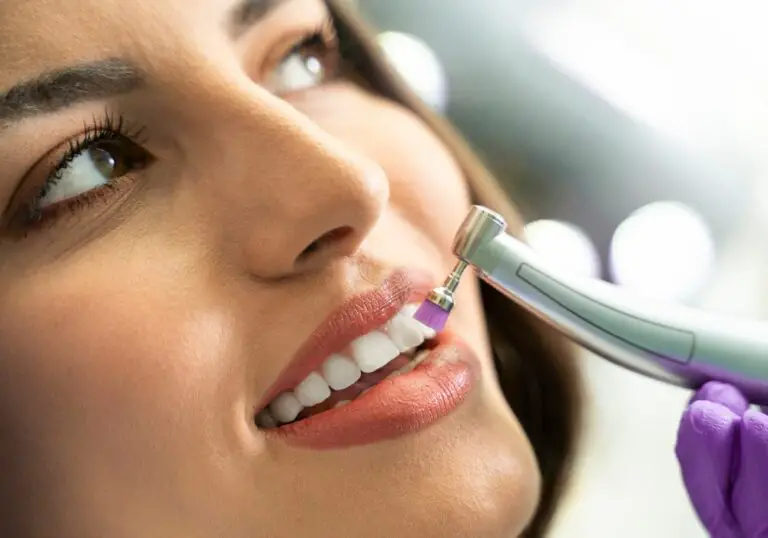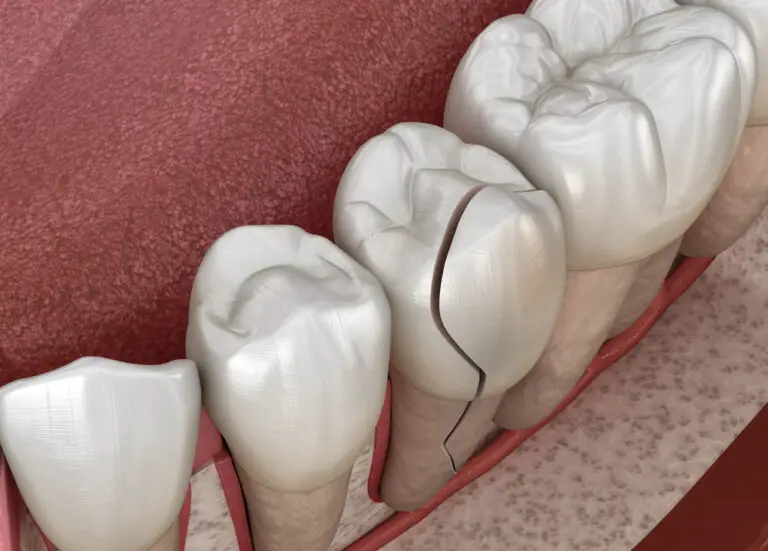As an expectant or new parent, you likely can’t wait for exciting milestones like your baby’s first step, first word, and yes, even the arrival of their first tooth! While infants are born toothless, most will sprout their first pearly white between 4-7 months of age. However, some babies pop a tooth as early as 3 months, while others don’t see their first peek through until 12-14 months or later.
Knowing general teething timelines helps you monitor this developmental landmark and prepare for supporting your baby’s emerging dental needs. When should you anticipate those initial teeth making an appearance? And how should you care for brand new chompers? Understanding the teething process sets your little one up for a lifetime of healthy smiles.
How Do Baby Teeth Develop?
Baby teeth begin forming well before birth, starting when the baby is still an embryo:
- 6 weeks gestation – The jaws and cheeks start developing in the womb. This structures the base of the mouth and future teeth.
- 12-16 weeks – Tooth buds for the baby teeth start growing under the gums. Each bud will eventually become one individual tooth.
- 28 weeks – The lower jaw and front teeth begin to calcify into hard tissue.
- 3-6 months after birth – Calcification continues as the teeth prepare to break through the gums and erupt.
While hidden in the gums throughout pregnancy, your baby’s teeth are already setting the foundation for their future smile. But when can you expect to actually see those pearly whites peek through?
Typical Age Ranges Baby Teeth Emerge
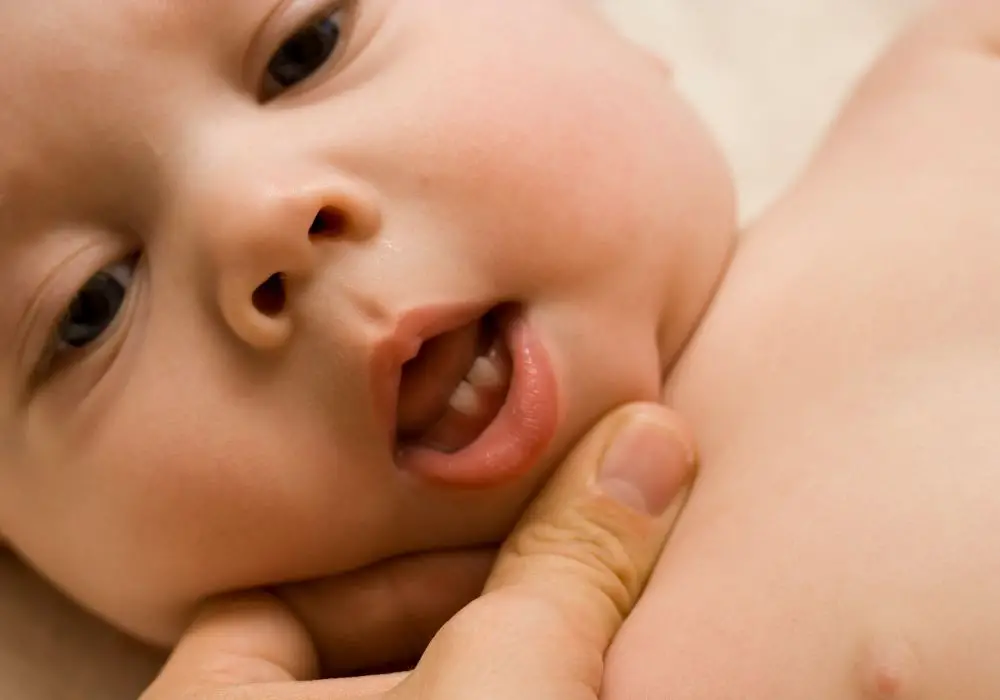
Here’s a more detailed overview of when various baby teeth typically come through:
0-3 months
While rare, some babies are born with a few teeth already erupted through the gums. Others may pop their first tooth within a few weeks or months after birth. Early teethers may see their lower central incisors arrive between 2-3 months.
4-7 months
The most common window for the first tooth is 4-7 months. Around 6 months is average. These earliest chompers are usually the two bottom central incisors in the front middle. Their sharp, spiky shape helps your infant grasp and bite.
8-12 months
After the bottom front teeth arrive, you can expect more to follow soon. Between 8-12 months, the top four front teeth (central incisors and lateral incisors) start coming through. Some babies get all front upper and lower incisors between 7-9 months. Those four choppers on bottom and four up top make eight total.
10-16 months
Around a year to a year and a half is when your baby will likely get their first molars. These bigger teeth in the back are key for chewing and grinding food. The bottom rear molars often emerge before the top pair.
13-19 months
Following the incisors and first molars, the snaggle-toothed canines start poking through between 13-19 months. These fang-like teeth help grip, tear, and rip foods. They also impact the appearance of your baby’s smile.
16-22 months
The second set of molars erupts between 16-22 months. Your baby may now have a total of 16 teeth. Molars play a major role in eating, chewing, and proper nutrition as babies transition to more solid foods.
24-33 months
Finally, between ages 2 and 3, the last set of molars furthest back will come through. These final 4 teeth give your toddler a full set of 20 baby teeth. Proper biting, chewing, speaking, and tooth alignment pave the way to the permanent adult teeth.
As you can see, getting teeth is a gradual process spanning many months, with the full set typically not complete until a child is around age 3. Every baby follows their own timeline, but this gives a general overview of what to expect.
Signs Your Baby Is Teething

Wondering if your little one is about to sprout a tooth? Look for these common signs of teething:
- Increased crying and fussiness
- Drooling more than usual
- Swollen or puffy gums
- Chewing behaviors and desire to gnaw on toys or fingers
- Rash or redness around the mouth
- Pulling on ears
- Difficulty sleeping
- Loss of appetite
- Mild fever
You know your baby best. If you notice sudden increased irritability, trouble sleeping, gnawing behaviors, extra drool, or rashes around their mouth, teeth may be on the way. Other developmental factors can cause fussiness, but these classic symptoms often indicate teething.
The pressure of teeth under the gums causes discomfort. While annoying for babies, it’s an essential part of the eruption process. Providing relief makes this transitional time more comfortable.
Soothing a Teething Baby
While teething symptoms are common, there are ways to soothe your uncomfortable child:
- Gently massage swollen gums by rubbing with a clean finger in circular motions
- Allow chewing on a chilled (not frozen) teether or clean wet washcloth
- Use gum numbing products like Orajel sparingly under pediatrician guidance
- Give appropriate dosages of infant acetaminophen or ibuprofen
- Stick to a consistent naptime and bedtime routine
- Hold and comfort your baby close with cuddles and distraction
Teething pain tends to worsen at night when saliva flow is lowest. A dose of pain reliever before bedtime can help an irritable, teething baby rest more comfortably.
Always discuss any medications or teething aids with your pediatrician first to ensure safety and appropriate usage for your child’s age.
Teething Myths vs. Facts

Various myths and misconceptions surround teething. Here’s the reality behind some common teething folklore:
Myth 1: Teething causes illness.
Fact: While low fevers can occasionally accompany teething, serious infections and illness are not caused by erupting teeth. Seek medical treatment for any abnormal symptoms.
Myth 2: You can feel teeth coming through the gums.
Fact: You cannot feel teeth under the gums. Swelling or ridges are from inflammation, not the teeth themselves poking through.
Myth 3: Pre-emptive chewing eases teething.
Fact: Allowing babies to gnaw on hard toys before teething can damage gums. Only offer appropriate teethers once teeth begin actively erupting through swollen gums.
Myth 4: Teething tablets relieve pain.
Fact: Teething tablets have posed choking dangers and contained toxic ingredients in the past. They are not dentist or pediatrician recommended.
Avoid relying on suspect teething advice or letting symptoms go unchecked. Instead, collaborate with your baby’s healthcare providers for effective, research-backed relief.
Caring for Baby Teeth
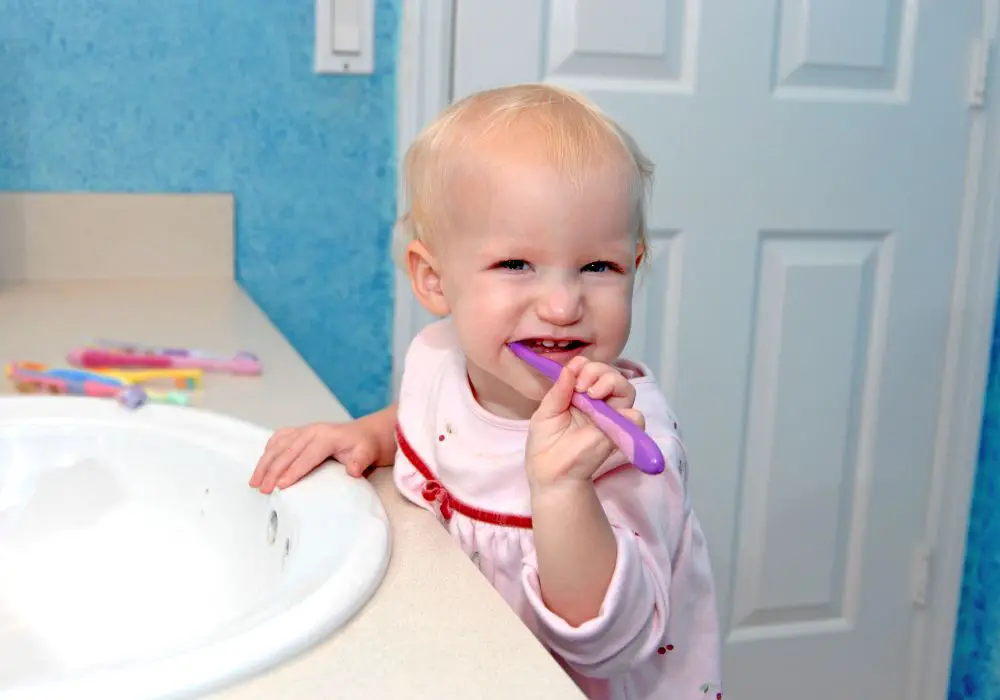
Alongside teething comes the need for care of new delicate choppers. To keep baby teeth healthy:
- Wipe gums clean before teeth erupt and brush gently as soon as teeth appear. Use a baby-sized toothbrush with a smear of fluoride toothpaste.
- Schedule your child’s first dental visit by 12 months old or within 6 months of getting the first tooth. Earlier assessment prevents problems.
- Avoid sharing utensils or food to limit spread of cavity-causing bacteria. Clean pacifiers with soap and water.
- Wean bottle feeding by 12-14 months and don’t put babies to bed with milk- or juice- filled bottles.
- Have kids drink only water between meals. Limit juice portions and avoid constant sipping throughout the day.
- Encourage chewing fruits, vegetables, or sugar-free gum to stimulate saliva after meals.
A gentle brushing routine and early professional cleanings helps protect precious new teeth as they sprout in the first year. Pediatric dental intervention can resolve bite or alignment issues early on.
Visiting the Pediatric Dentist
The American Dental Association and American Academy of Pediatric Dentistry recommend scheduling your baby’s first dental visit by 12 months old or within 6 months of seeing the first tooth emerge, whichever comes first.
Starting dental visits early allows the dentist to:
- Check for genetic risks impacting tooth development
- Assess the risk level for cavities
- Identify any oral health concerns as they emerge
- Determine if spacing, bite, or alignment is on track as more teeth erupt
- Clean and apply protective fluoride varnish to newly emerged teeth
- Provide guidance on hygiene, diet, teething, and preventing baby bottle tooth decay
While first visits focus on evaluation and prevention rather than treatment, early intervention for developmental concerns may be recommended. Catching problems early while tooth and jaw bones are still forming prevents extensive treatment later on.
Regular professional cleaning and examination every 6 months maintains oral health as your baby’s smile evolves.
Teething Questions and Answers
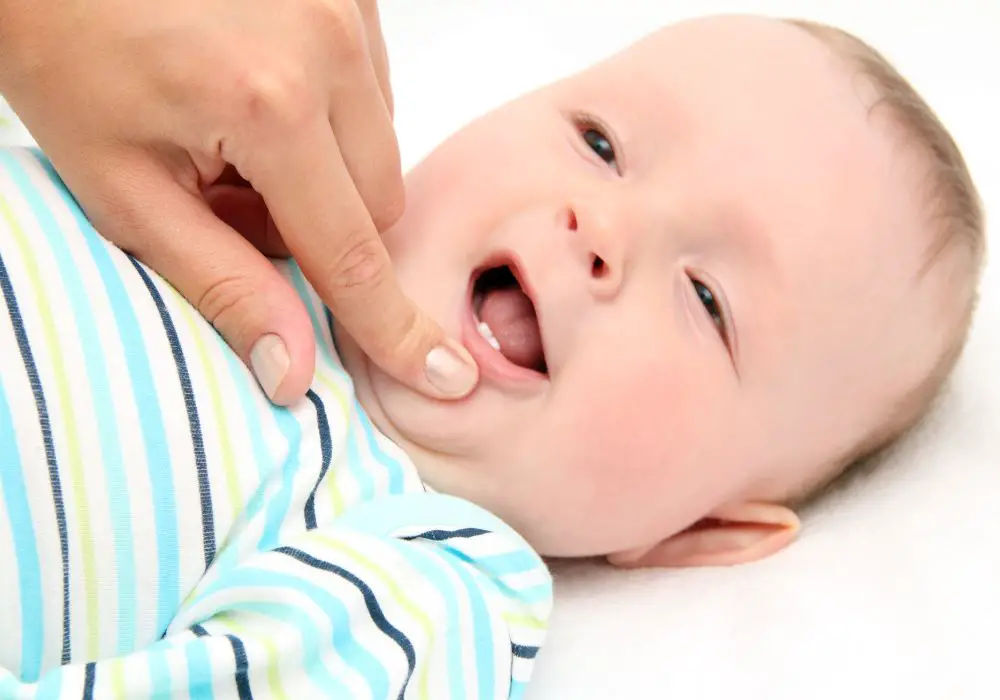
Here are answers to some frequently asked questions about babies getting teeth:
How do I clean my baby’s teeth?
Use a soft infant toothbrush and fluoride toothpaste made for babies once teeth appear. Brush twice daily gently along the gumline. Floss between tight teeth.
What should I do if a tooth seems loose or chipped?
Contact your pediatric dentist if you notice any damage, discoloration, or loss of an erupted baby tooth. The underlying permanent tooth may also be affected.
Is it safe to share a spoon with my baby?
No, avoid sharing utensils as it spreads decay-causing bacteria to your child. Use one assigned spoon just for feeding your baby.
Are amber teething necklaces safe?
No, dentists and pediatricians recommend against amber teething jewelry due to choking and strangulation risks. There is also no evidence they relieve teething pain.
When does my child need to start seeing the dentist?
Bring your child for a first dental appointment by 12 months or within 6 months of getting their first tooth to spot potential problems early. Then visit every 6 months for cleanings.
Regular dental visits support your baby’s oral health from those first new teeth through the teen years. Seek professional advice to make teething and emerging smiles smooth.
Key Teething Takeaways
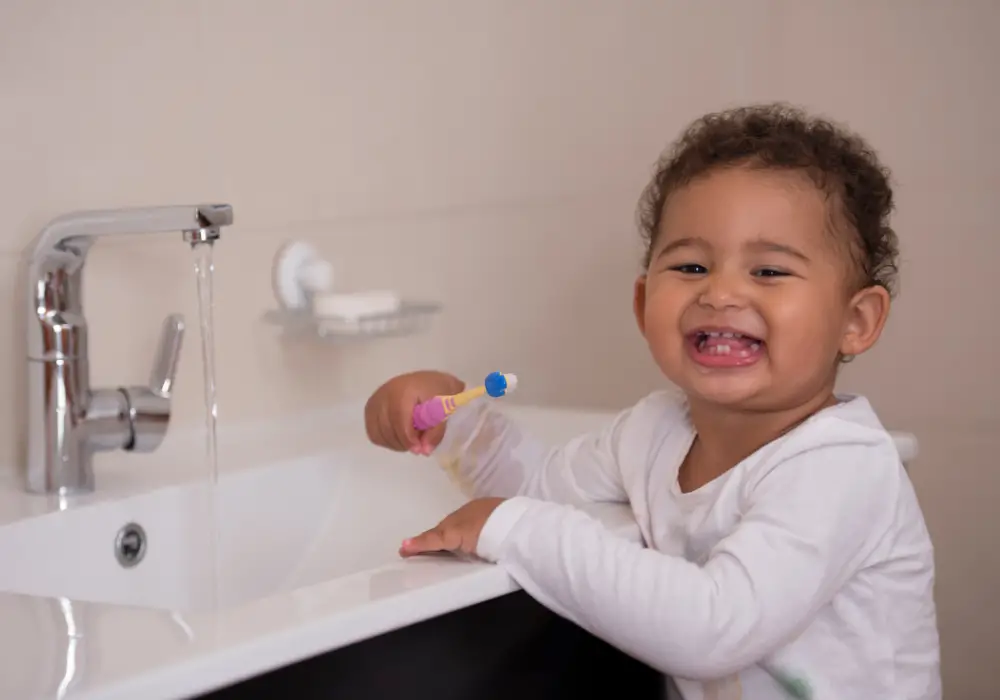
- Most babies sprout their first tooth around 6 months, though the range is 3 months to 1 year.
- The order teeth generally emerge: bottom front incisors, upper front incisors, first molars, canines, and finally second molars.
- Monitor for teething symptoms like increased drool, swollen gums, and chewing behaviors to anticipate teeth poking through.
- Chilled teethers, gum rubbing, acetaminophen, and increased bedtime comfort help soothe teething woes.
- Start gentle brushing as soon as the first tooth appears using fluoride toothpaste made for babies.
- See a pediatric dentist by 12 months or within 6 months of the first tooth coming in to prevent problems.
- Regular dental visits, cleanings, and early evaluation ensure healthy development of baby teeth and permanent teeth.
While getting teeth causes some inevitable discomfort for babies, understanding this process allows you to support your child through their emerging smile.
Conclusion
The arrival of your baby’s first tooth is an exciting time! While teething can be uncomfortable, those little chompers pave the way for clear speech, healthy nutrition, and lasting dental development. Most babies sprout their first pearly white tooth between 4-7 months of age. But the eruption timeline varies, with some babies getting teeth as early as 3 months and others not seeing their first peek through until 12 months or later.
Watching for classic teething symptoms like fussy behavior, increased drooling, and swollen gums can help you anticipate tooth breakthroughs. Offering appropriate pain relief, initiating gentle brushing, scheduling early dental visits, and paying attention to diet supports healthy emerging teeth. With attentive oral care and your dentist’s guidance, your baby’s new smile will bring joy for years to come!
FAQ
Q1: What foods help relieve teething pain?
Chilled fruits like apples or berries can help numb gums. Hard crunchy foods let babies gnaw and relieve pressure. Dairy provides protein and calcium for tooth growth. Avoid hard, tooth-cracking foods or anything that poses a choking risk.
Q2: Is diarrhea or vomiting normal during teething?
It’s common for babies to have slight loose stools or decreased appetite from excessive drool swallowing. But fever, diarrhea, or vomiting need medical assessment as they could indicate illness versus just teething.
Q3: How can I help my baby sleep when teething?
Try giving an approved dose of acetaminophen or ibuprofen before bed. Use cool teethers or wet washcloths to massage sore gums. Keep bedtime routines consistent and make the sleep area calming. Have patience during night wakings.
Q4: What kind of toothbrush should I use on baby teeth?
Look for an infant toothbrush with extra-soft bristles and a small head able to access teeth in the back. Replace it every 3-4 months as bristles wear. You can also wrap gauze around your finger for gentle gum cleaning pre-teeth.
Q5: When does teeth grinding become concerning?
Some harmless teeth grinding is normal while teeth push through and jaws align. But mention consistent grinding, especially accompanying ear pain or fever, to your pediatric dentist, as it could indicate infection. Limited night grinding typically resolves on its own.

